 The United Nations International Panel on Climate Change (IPCC) has just published its most comprehensive report so far. It finds that ‘human activities, principally through emissions of greenhouse gases, have unequivocally caused global warming’. This has led to widespread and rapid changes in climate and biodiversity and to more extreme weather patterns, such as droughts, floods and hurricanes. What is more, the distribution of these effects is uneven, with communities who have contributed the least to current climate change being disproportionately affected.
The United Nations International Panel on Climate Change (IPCC) has just published its most comprehensive report so far. It finds that ‘human activities, principally through emissions of greenhouse gases, have unequivocally caused global warming’. This has led to widespread and rapid changes in climate and biodiversity and to more extreme weather patterns, such as droughts, floods and hurricanes. What is more, the distribution of these effects is uneven, with communities who have contributed the least to current climate change being disproportionately affected.
At the 2015 COP21 climate change conference in Paris (see also), it was agreed to adopt policies to limit the increase in global temperatures to ‘well below’ 2°C above pre-industrial levels and to make an effort to limit it to 1.5°C. Global temperatures have already risen 1.1°C above 1850–1900 levels and are set to reach 1.5°C in the early 2030s. Every increment of global warming will intensify ‘multiple and concurrent hazards’.
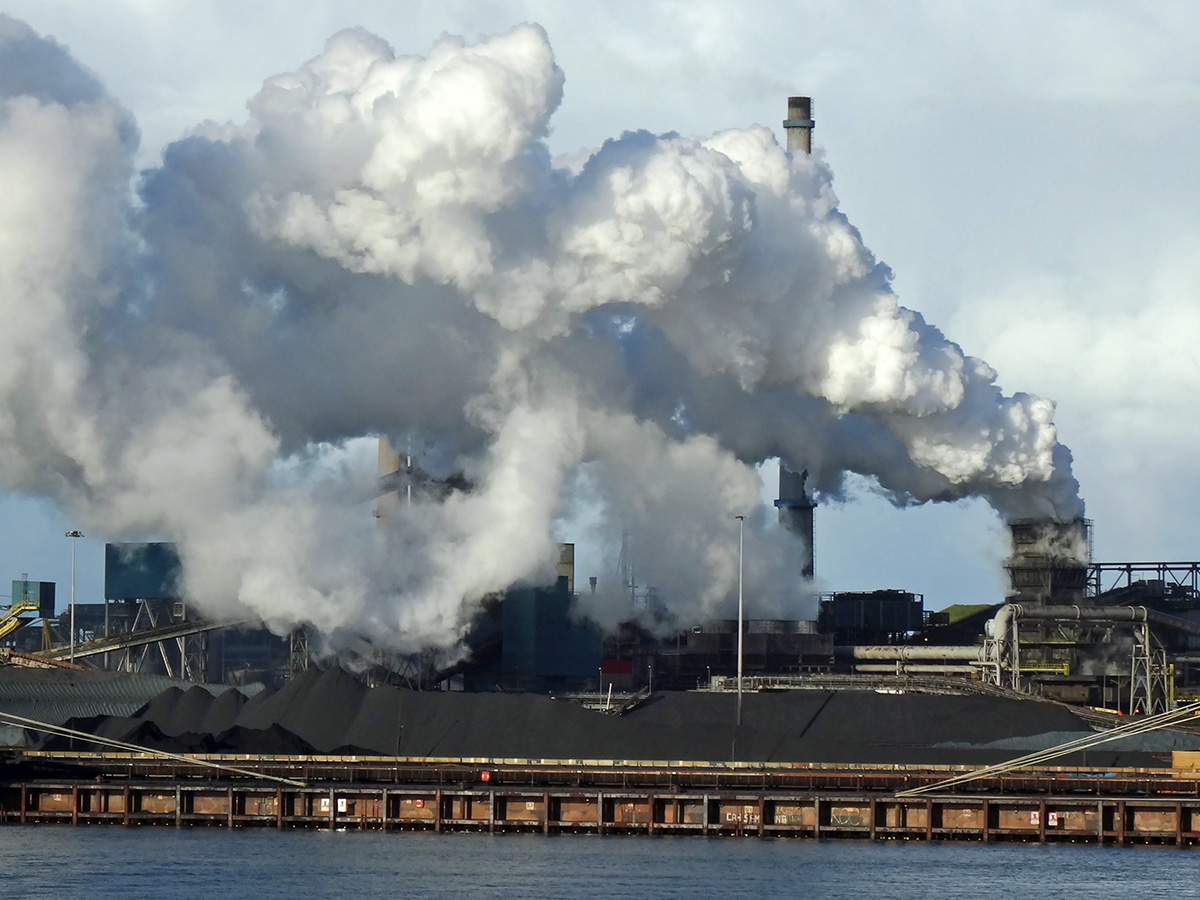 Deep, rapid and sustained reductions in emissions would slow down the rise in global temperatures, but even with such reductions, temperatures will still exceed 1.5°C in the next few years and, even under the best-case scenario, would not fall below 1.5°C again until the end of the 21st century. Under more pessimistic scenarios, global temperatures could rise to 2.7°C above pre-industrial levels by the end of the century under an intermediate greenhouse gas emissions scenario and to 4.4°C under a very high emissions scenario. Anything above 2°C would be likely to have catastrophic effects. The longer countries wait to take action, the greater the rise in global temperatures and hence the greater the damage and the more costly it will be to rectify it.
Deep, rapid and sustained reductions in emissions would slow down the rise in global temperatures, but even with such reductions, temperatures will still exceed 1.5°C in the next few years and, even under the best-case scenario, would not fall below 1.5°C again until the end of the 21st century. Under more pessimistic scenarios, global temperatures could rise to 2.7°C above pre-industrial levels by the end of the century under an intermediate greenhouse gas emissions scenario and to 4.4°C under a very high emissions scenario. Anything above 2°C would be likely to have catastrophic effects. The longer countries wait to take action, the greater the rise in global temperatures and hence the greater the damage and the more costly it will be to rectify it.
‘For any given future warming level… projected long-term impacts are up to multiple times higher than currently observed (high confidence). Risks and projected adverse impacts and related losses and damages from climate change escalate with every increment of global warming (very high confidence). Climatic and non-climatic risks will increasingly interact, creating compound and cascading risks that are more complex and difficult to manage (high confidence).’ (Paragraph B2)
But the report is not all ‘doom and gloom’. It is possible to limit global warming to 1.5°C or only a little over by making rapid, deep and, in most cases, immediate greenhouse gas emissions reductions in all sectors and reaching net zero emissions in the early 2050s. Science and technology have the answers – answers that are now much cheaper and more available than back in 2015 when the 1.5°C target was agreed. But what it does require is doing ‘everything, everywhere, all at once’. And that requires political will and the right economic incentives.
The politics and economics of achieving net zero
In terms of the politics, there is general global agreement by governments about the likely effects of climate change. And most governments agree that action needs to be taken. However, there are three key political problems.
The first is that the costs of action will be borne now, while the benefits of action will accrue over a much longer period of time. This links to the second problem – the mismatch between the lives of governments and the long-term effects of climate change. If governments put off doing anything now and merely promise that something will be done in the future, they will not have to take unpopular actions, such as raising taxes on energy, private transport and certain goods or banning various activities. Future governments will have to sort things out, by when, although the problems will be greater, the existing politicians will no longer be in power.
 The third problem concerns the distribution of the costs and benefits of action. The major emitters of carbon are the rich countries, while the major sufferers are poor people in countries subject to drought, flooding and rising sea levels. Not surprisingly, who should cut down on emissions and pay for the mitigation necessary in many of the poorer countries is a difficult political issue, which is why it’s much easier to say what needs to be achieved overall than precisely what measures should be taken by which countries.
The third problem concerns the distribution of the costs and benefits of action. The major emitters of carbon are the rich countries, while the major sufferers are poor people in countries subject to drought, flooding and rising sea levels. Not surprisingly, who should cut down on emissions and pay for the mitigation necessary in many of the poorer countries is a difficult political issue, which is why it’s much easier to say what needs to be achieved overall than precisely what measures should be taken by which countries.
These problems reflect the fact that many, if not most, of the environmental costs of production and consumption are external costs – costs borne, not by the direct producer or consumer, but by other people at other places and/or in the future.
Nevertheless, the relative costs of moving to greener production and consumption are falling. The costs of renewable energy, including solar power, onshore and offshore wind and hydroelectric power are falling relative to that generated from fossil fuels. At the same time, the take up of electric cars is likely to continue rising as battery technology improves. This does, of course, require an increase in charging infrastructure. Domestic heat pump technology is improving and home insulation methods are becoming more efficient.
Persuading consumers and firms to take account of environmental externalities could in part be achieved by education. It makes it much easier for politicians to take appropriate action now if their populations are on board. There has been increasing awareness over the years of the environmental impact of people’s actions. People have become more willing to take responsibility for the world that future generations will inherit. This is helped both by education in schools and colleges and by frequent items in the media.
But incentives also have a major part to play. To internalise environmental externalities, external costs could be taxed and external benefits subsidised.
The effect of a carbon tax on production
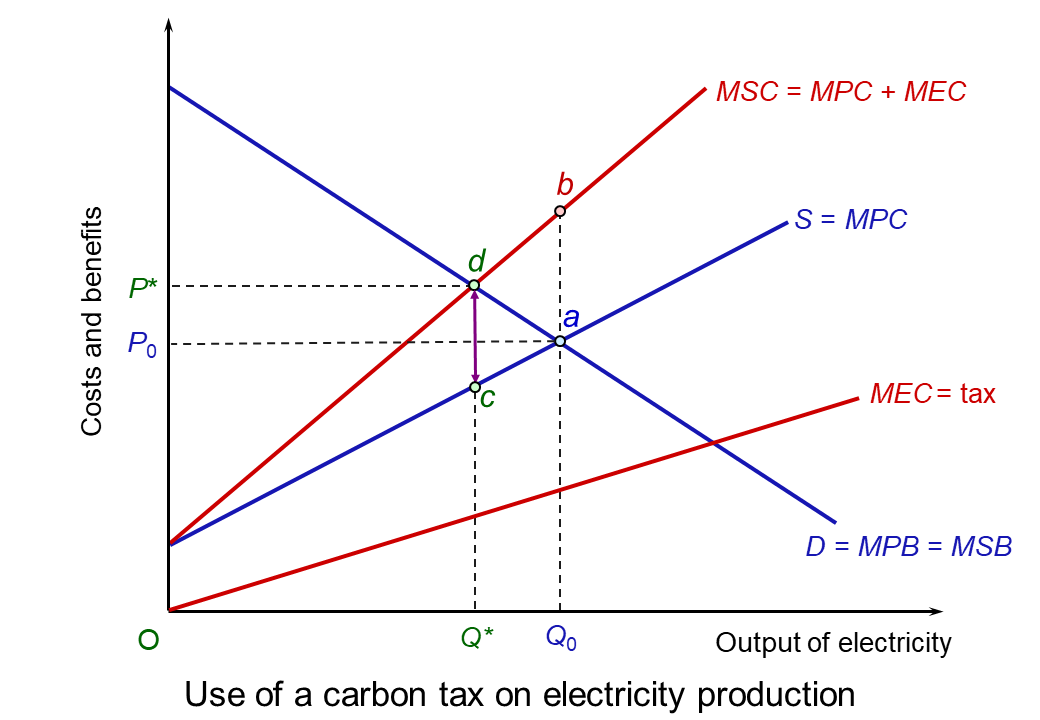 The use of taxes to reduce activities with negative environmental externalities is illustrated in the diagram (click here for a PowerPoint). It takes the case of carbon emissions from coal-fired electricity generation in a large country. To keep the analysis simple, it is assumed that all electricity in the country is generated from coal-fired power stations and that there are many such power stations, making the market perfectly competitive.
The use of taxes to reduce activities with negative environmental externalities is illustrated in the diagram (click here for a PowerPoint). It takes the case of carbon emissions from coal-fired electricity generation in a large country. To keep the analysis simple, it is assumed that all electricity in the country is generated from coal-fired power stations and that there are many such power stations, making the market perfectly competitive.
It is assumed that all the benefits from electricity production accrue solely to the consumers of electricity (i.e. there are no external benefits from consumption). Marginal private and marginal social benefits of the production of electricity are thus the same (MPB = MSB). The curve slopes downwards because, with a downward-sloping demand for electricity, higher output results in a lower marginal benefit (diminishing marginal utility).
Competitive market forces, with producers and consumers responding only to private costs and benefits, will result in a market equilibrium at point a in the diagram: i.e. where demand equals supply. The market equilibrium price is P0 while the market equilibrium quantity is Q0. However the presence of external costs in production means that MSC > MPC. In other words, MEC = b – a.
The socially optimal output would be Q* where P = MSB = MSC, achieved at the socially optimal price of P*. This is illustrated at point d and clearly shows how external costs of production in a perfectly competitive market result in overproduction: i.e. Q0 > Q*. From society’s point of view, too much electricity is being produced and consumed.
If a carbon tax of d – c is imposed on the electricity producers, it will now be in producers’ interests to produce at Q*, where their new private marginal costs (including tax) equals their marginal private benefit.
But this brings us back to the politics of measures to reduce emissions. People do not like paying higher taxes. In his latest Budget, the UK Chancellor, Jeremy Hunt, decided not to raise fuel duties by the 12p that had been previously planned, despite fuel prices having recently fallen. Meanwhile, charging prices for electric cars have risen.
Other economic measures
 A simpler method for dealing with environmental externalities is ban certain activities that omit CO2. For example, in the UK there will be a ban on the sale of new petrol and diesel cars and vans from 2030 (with the exception of some low-emission hybrids until 2035). In the EU there will be a similar ban from 2035. Clearly, such measures are only suitable when there are non-emitting alternatives.
A simpler method for dealing with environmental externalities is ban certain activities that omit CO2. For example, in the UK there will be a ban on the sale of new petrol and diesel cars and vans from 2030 (with the exception of some low-emission hybrids until 2035). In the EU there will be a similar ban from 2035. Clearly, such measures are only suitable when there are non-emitting alternatives.
Another alternative is a cap-and-trade system, such as the European Emissions Trading Scheme. It involves setting quotas for emissions and allowing firms which manage to cut emissions to sell their surplus permits to less efficient firms. This puts a price pressure on firms to be more efficient. But the quotas (the ‘cap’) must be sufficiently tight if emissions are going to be cut to desired levels. Nevertheless, it is an efficient way of cutting emissions as it gives a competitive advantage to low-emission producers.
Conclusion
If the problem of global warming is to be limited to 1.5°C, or only very little above, multiple solutions will need to be found and there must be a combination of political will, economic incentives and the mobilisation of scientific and technical know-how. As the Secretary-General of the United Nations, António Guterres, stated in launching the new report:
This report is a clarion call to massively fast-track climate efforts by every country and every sector and on every timeframe. In short, our world needs climate action on all fronts – everything, everywhere, all at once.
Report
Videos
Articles
- Climate damage is worsening faster than expected, but there’s still reason for optimism – 4 essential reads on the IPCC report
The Conversation, Stacy Morford at al (20/3/23)
- UN climate scientists are running out of ways to warn us
Vox, Rebecca Leber and Umair Irfan (20/3/23)
- Expert reaction to the AR6 synthesis report, as published by the IPCC
Science Media Centre (20/3/23)
- ‘The climate time-bomb is ticking’: The world is running out of time to avoid catastrophe, new UN report warns
CNN, Laura Paddison (20/3/23)
- UN climate report: Scientists release ‘survival guide’ to avert climate disaster
BBC News, Matt McGrath and Georgina Rannard (20/3/23)
- Five things we’ve learned from UN climate report
BBC News, Matt McGrath (20/3/23)
- Climate change: Can we really take CO2 back out the air?
BBC Future, Jocelyn Timperley (21/3/23)
- Scientists deliver ‘final warning’ on climate crisis: act now or it’s too late
The Guardian, Fiona Harvey (20/3/23)
- From climate change ‘certainty’ to rapid decline: a timeline of IPCC reports
The Guardian, Damian Carrington (20/3/23)
- Humanity at the climate crossroads: highway to hell or a livable future?
The Guardian, Damian Carrington (20/3/23)
 IPCC report: Here’s how we can defuse the ‘ticking time bomb’ of climate change
IPCC report: Here’s how we can defuse the ‘ticking time bomb’ of climate changeEuronews, Rosie Frost (21/3/23)
- Now or never: One of the biggest climate reports ever shows time is running out
NBC News, Evan Bush and Denise Chow (20/3/23)
Questions
- Why might countries not do ‘everything, everywhere, all at once’ to avert climate change?
- What might an optimist conclude from the ICC report?
- To what extent is climate change an economic problem?
- On a diagram similar to the one above, show how a subsidy could be used to internalise positive externalities.
- How might countries reduce the consumption of fossil fuels in the most efficient way? Are they likely to want to do this? Explain.
- Is a ‘cap-and-trade’ (tradable permits) system (a) an effective means of reducing emissions; (b) an efficient system?
 The median pay of chief executives of the FTSE 100 companies rose 11% in 2017 to £3.93 million per year, according to figures released by the High Pay Centre. By contrast, the median pay of full-time workers rose by just 2%. Given two huge pay increases for the CEOs of Persimmon and Melrose Industries of £47.1 million and £42.8 million respectively, the mean CEO pay rose even more – by 23%, from £4.58 million in 2016 to £5.66 million in 2017. This brings the ratio of the mean pay of FTSE 100 CEOs to that of their employees to 145:1. In 2000, the ratio was around 45:1.
The median pay of chief executives of the FTSE 100 companies rose 11% in 2017 to £3.93 million per year, according to figures released by the High Pay Centre. By contrast, the median pay of full-time workers rose by just 2%. Given two huge pay increases for the CEOs of Persimmon and Melrose Industries of £47.1 million and £42.8 million respectively, the mean CEO pay rose even more – by 23%, from £4.58 million in 2016 to £5.66 million in 2017. This brings the ratio of the mean pay of FTSE 100 CEOs to that of their employees to 145:1. In 2000, the ratio was around 45:1.
These huge pay increases are despite criticisms from shareholders and the government over excessive boardroom pay awards and the desire for more transparency. In fact, under new legislation, companies with more than 250 employees must publish the ratio of the CEO’s total remuneration to the full-time equivalent pay of their UK employees on the 25th, 50th (median) and 75th percentiles. The annual figures will be for pay starting from the financial year beginning in 2019, which for most companies would mean the year from April 2019 to April 2020. Such a system has been introduced in the USA this year.
So why has the gap in pay widened so much? One reason is that there is no formal mechanism whereby workers can apply downward pressure on such awards. Although Theresa May, in her campaign to become Prime Minister in 2016, promised to put workers on company boards, the government has since abandoned the idea.
 Executive pay is awarded by remuneration committees. Membership of such committees consists of independent non-executive directors, but their degree of independence has frequently been called into question and there has been much criticism of such committees being influenced by their highest paying competitors or peers. This has had the effect of ratcheting up executive pay.
Executive pay is awarded by remuneration committees. Membership of such committees consists of independent non-executive directors, but their degree of independence has frequently been called into question and there has been much criticism of such committees being influenced by their highest paying competitors or peers. This has had the effect of ratcheting up executive pay.
Then there is the question of the non-salary element in executive pay. The incentive and bonus payments are often linked to the short-term performance of the company, as reflected in, for example, the company’s share price. In a period when share prices in general rise rapidly – as we have seen over the past two years – executive pay tends to rise rapidly too. A frequent criticism of large UK businesses is that they have been too short-termist. What is more, bonuses are often paid despite poor performance.
There has been some move in recent years to make incentive pay linked more to long-term performance, but this has still led to many CEOs getting large pay increases despite lack-lustre long-term performance.
Then there is the question of shareholders and their influence on executive pay. Despite protests by many smaller shareholders, a large proportion of shares are owned by investment funds and their managers are often only too happy to vote through large executive pay increases at shareholder meetings.
So, while the pressures for containing the rise in executive pay remain small, the pay gap is likely to continue to widen. This raises the whole question of a society becoming increasingly divided between the few at the top and a large number of people ‘just getting by’ – or not even that. Will this make society even more fractured and ill at ease with itself?
Articles
Information and data
Questions
- How would you set about establishing whether CEOs’ pay is related to their marginal revenue product?
- To what extent is executive pay a reflection of oligopolistic/oligopsonistic behaviour?
- In what ways can game theory shed light on the process of setting the remuneration packages of CEOs? Is there a Nash equilibrium?
- What are the advantages and disadvantages of linking senior executives’ remuneration to (a) short-term company performance; (b) long-term company performance?
- What is/are the best indicator(s) of long-term company performance for determining the worth of senior executives?
- Consider the arguments for and against capping the ratio of CEOs’ remuneration to a particular ratio of either the mean or median pay of employees. What particular ratio might be worth considering for such a cap?
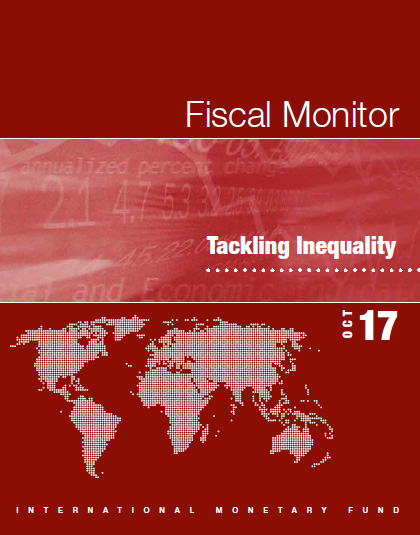 The latest edition of the IMF’s Fiscal Monitor, ‘Tackling Inequality’ challenges conventional wisdom that policies to reduce inequality will also reduce economic growth.
The latest edition of the IMF’s Fiscal Monitor, ‘Tackling Inequality’ challenges conventional wisdom that policies to reduce inequality will also reduce economic growth.
While some inequality is inevitable in a market-based economic system, excessive inequality can erode social cohesion, lead to political polarization, and ultimately lower economic growth.
The IMF looks at three possible policy alternatives to reduce inequality without damaging economic growth
The first is a rise in personal income tax rates for top earners. Since top rates have been cut in most countries, with the OECD average falling from 62% to 35% over the past 30 years, the IMF maintains that there is considerable scope of raising top rates, with the optimum being around 44%. Evidence suggests that income tax elasticity is low at most countries’ current top rates, meaning that a rise in top income tax rates would only have a small disincentive effect on earnings.
 An increased progressiveness of income tax should be backed by sufficient taxes on capital to prevent income being reclassified as capital. Different types of wealth tax, such as inheritance tax, could also be considered. Countries should also reduce the opportunities for tax evasion.
An increased progressiveness of income tax should be backed by sufficient taxes on capital to prevent income being reclassified as capital. Different types of wealth tax, such as inheritance tax, could also be considered. Countries should also reduce the opportunities for tax evasion.
The second policy alternative is a universal basic income for all people. This could be achieved by various means, such as tax credits, child benefits and other cash benefits, or minimum wages plus benefits for the unemployed or non-employed.
The third is better access to health and education, both for their direct effect on reducing inequality and for improving productivity and hence people’s earning potential.
In all three cases, fiscal policy can help through a combination of taxes, benefits and public expenditure on social infrastructure and human capital.
But a major problem with using increased tax rates is international competition, especially with corporation tax rates. Countries are keen to attract international investment by having corporation tax rates lower than their rivals. But, of course, countries cannot all have a lower rate than each other. The attempt to do so simply leads to a general lowering of corporation tax rates (see chart in The Economist article) – to a race to the bottom. The Nash equilibrium rate of such a game is zero!
Videos
 Raising Taxes on the Rich Won’t Necessarily Curb Growth, IMF Says Bloomberg, Ben Holland and Andrew Mayeda (11/10/17)
Raising Taxes on the Rich Won’t Necessarily Curb Growth, IMF Says Bloomberg, Ben Holland and Andrew Mayeda (11/10/17)
 The Fiscal Monitor, Introduction IMF (October 2017)
The Fiscal Monitor, Introduction IMF (October 2017)
 Transcript of the Press Conference on the Release of the October 2017 Fiscal Monitor IMF (12/10/17)
Transcript of the Press Conference on the Release of the October 2017 Fiscal Monitor IMF (12/10/17)
Articles
Higher taxes can lower inequality without denting economic growth The Economist, Buttonwood (19/10/17)
Trump says the US has the highest corporate tax rate in the world. He’s wrong. Vox, Zeeshan Aleem (31/8/17)
Reducing inequality need not hurt growth Livemint, Ajit Ranade (18/10/17)
IMF: higher taxes for rich will cut inequality without hitting growth The Guardian, Larry Elliott and Heather Stewart (12/10/17)
IMF Fiscal Monitor
IMF Fiscal Monitor: Tackling Inequality – Landing Page IMF (October 2017)
Opening Remarks of Vitor Gaspar, Director of the Fiscal Affairs Department at a Press Conference Presenting the Fall 2017 Fiscal Monitor: Tackling Inequality IMF (11/10/17)
Fiscal Monitor, Tackling Inequality – Full Text IMF (October 2017)
Questions
- Referring to the October 2017 Fiscal Monitor, linked above, what arguments does the IMF use for suggesting that the optimal top rate of income tax is considerably higher than the current OECD average?
- What are the arguments for introducing a universal basic income? Should this depend on people’s circumstances, such as the number of their children, assets, such as savings or property, and housing costs?
- Find out the details of the UK government’s Universal Credit. Does this classify as a universal basic income?
- Why may governments reject the IMF’s policy recommendations to tackle inequality?
- In what sense can better access to health and education be seen as a means of reducing inequality? How is inequality being defined in this case?
- Find out what the UK Labour Party’s policy is on rates of income tax for top earners. Is this consistent with the IMF’s policy recommendations?
- What does the IMF report suggest about the shape of the Laffer curve?
- Explain what is meant by tax elasticity and how it relates to the Laffer curve?
 Together with Formula 1, tennis is the other sport I love – and my favourite player by far is Rafa!
Together with Formula 1, tennis is the other sport I love – and my favourite player by far is Rafa!
We often apply game theory to various sports and consider how players, teams and individuals can think strategically. One of the big debates in tennis is ‘who is the best ever’ and I argue that Nadal is the greatest, based on a huge range of metrics.
I saw this article in the Economist, providing analysis and comparison between some of the best tennis players. It shows how we can use economic thinking, probability, game theory and analysis to come to something of an answer about who is the greatest, considering the various players’ runs to the title in the Grand Slams. Of course the reason I’m posting this is because according to the Economist, Rafa is the best! And the reasoning is very sound. Enjoy. I certainly did.
Sorry Roger: Rafael Nadal is not just the King of Clay The Economist (13/09/17)
Questions
- What is game theory and why is it useful?
- How does the rating system aim to measure the skill of a tennis champion?
- In this particular scenario, why is it important to use probabilities?
- We can use game theory to think about penalty shoot outs and whether footballers play to the Nash equilibrium. Can we also use the Nash equilibrium when thinking about tennis? (Think about the serve!)
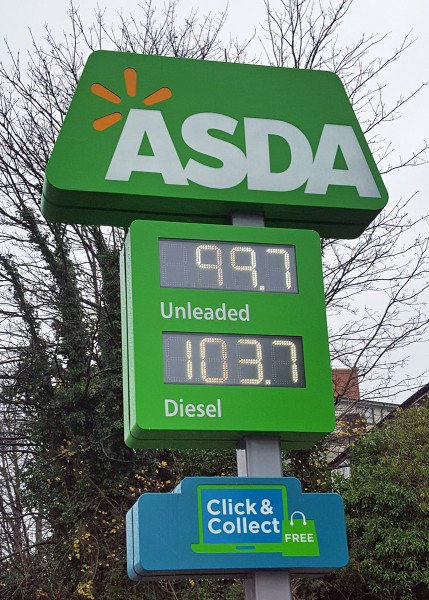 People are beginning to get used to low oil prices and acting as if they are going to remain low. Oil is trading at only a little over $30 per barrel and Saudi Arabia is unwilling to backtrack on its policy of maintaining its level of production and not seeking to prevent oil prices from falling. Currently, there is still a position of over supply and hence in the short term the price could continue falling – perhaps to $20 per barrel.
People are beginning to get used to low oil prices and acting as if they are going to remain low. Oil is trading at only a little over $30 per barrel and Saudi Arabia is unwilling to backtrack on its policy of maintaining its level of production and not seeking to prevent oil prices from falling. Currently, there is still a position of over supply and hence in the short term the price could continue falling – perhaps to $20 per barrel.
But what of the future? What will happen in the medium term (6 to 12 months) and the longer term? Investment in new oil wells, both conventional and shale oil, have declined substantially. The position of over supply could rapidly come to an end. The Telegraph article below quotes the International Energy Agency’s executive director, Fatih Birol, as saying:
“Investment in oil exploration and production across the world has been cut to the bone, falling 24% last year and an estimated 17% this year. This is… far below the minimum levels needed to keep up with future demand. …
It is easy for consumers to be lulled into complacency by ample stocks and low prices today, but they should heed the writing on the wall: the historic investment cuts raise the odds of unpleasant oil security surprises in the not too distant future.”
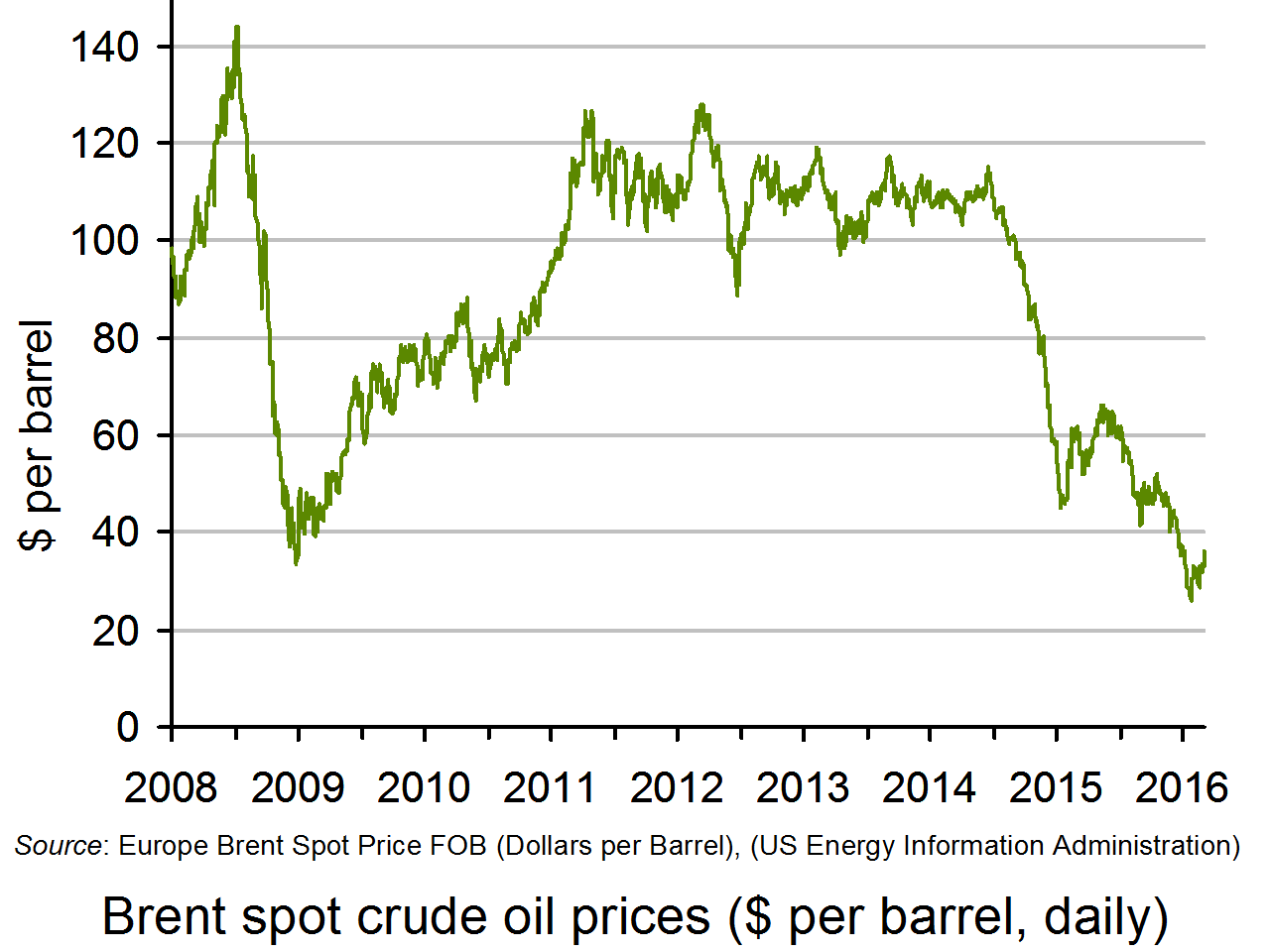 And in the Overview of the IEA’s 2016 Medium-Term Oil Market Report, it is stated that
And in the Overview of the IEA’s 2016 Medium-Term Oil Market Report, it is stated that
In today’s oil market there is hardly any spare production capacity other than in Saudi Arabia and Iran and significant investment is required just to maintain existing production before we move on to provide the new capacity needed to meet rising oil demand. The risk of a sharp oil price rise towards the later part of our forecast arising from insufficient investment is as potentially de-stabilising as the sharp oil price fall has proved to be.
The higher-cost conventional producers, such as Venezuela, Nigeria, Angola, Russia and off-shore producers, could take a long time to rebuild capacity as investment in conventional wells is costly, especially off-shore.
As far as shale oil producers is concerned – the prime target of Saudi Arabia’s policy of not cutting back supply – production could well bounce back after a relatively short time as wells are re-opened and investment in new wells is resumed.
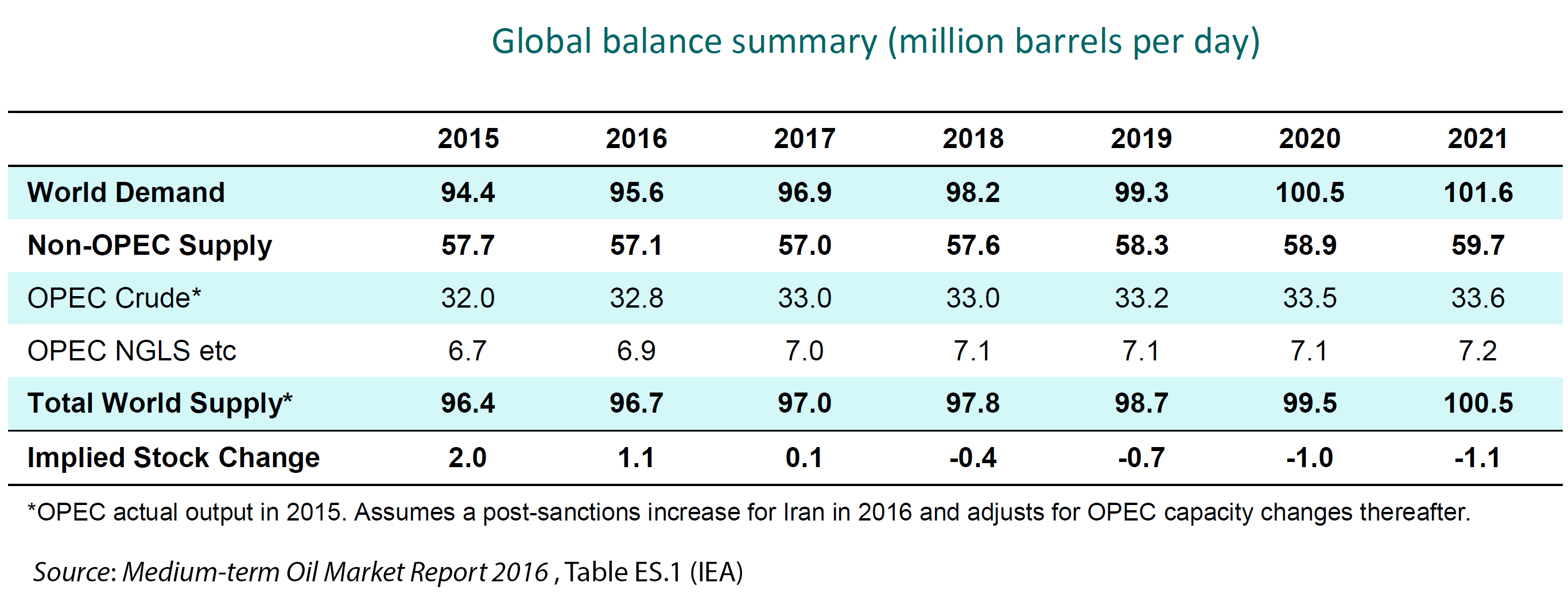
But, price rises in the medium term could then be followed by lower prices again a year or two thereafter as oil from new investment comes on stream: or they could continue rising if investment is insufficient. It depends on the overall balance of demand and supply. The table shows the IEA’s forecast of production and consumption and the effect on oil stocks. From 2018, it is predicting that consumption will exceed production and that, therefore, stocks will fall – and at an accelerating rate.
But just what happens to the balance of production and consumption will also depend on expectations. If shale oil investors believe that an oil price bounce is temporary, they are likely to hold off investing. But this will, in turn, help to sustain a price bounce, which in turn, could help to encourage investment. So expectations of investors will depend on what other investors expect to happen – a very difficult outcome to predict. It’s a form of Keynesian beauty contest (see the blog post A stock market beauty contest of the machines) where what is important is what other people think will happen, which in turn depends on what they think other people will do, and so on.
Webcast
 At $30 oil price, shale rebound may take much, much longer CNBC, Patti Domm , Bob Iaccino, Helima Croft and Matt Smith (25/2/16)
At $30 oil price, shale rebound may take much, much longer CNBC, Patti Domm , Bob Iaccino, Helima Croft and Matt Smith (25/2/16)
Article
Opec has failed to stop US shale revolution admits energy watchdog The Telegraph, Ambrose Evans-Pritchard (27/2/16)
Report
Medium-term Oil Market Report 2016: Overview International Energy Agency (IEA) (22/2/16)
Questions
- Using demand and supply diagrams, demonstrate (a) what happened to oil prices in 2015; (b) what is likely to happen to them in 2016; (c) what is likely to happen to them in 2017/18.
- Why have oil prices fallen so much over the past 12 months?
- Using aggregate demand and supply analysis, demonstrate the effect of lower oil prices on a national economy.
- What have have been the advantages and disadvantages of lower oil prices? In your answer, distinguish between the effects on different people, countries and the world generally.
- Why is oil supply more price elastic in the long run than in the short run?
- Why does supply elasticity vary between different types of oil fields (a) in the short run; (b) in the long run?
- What determines whether speculation about future oil prices is likely to be stabilising or destabilising?
- What role has OPEC played in determining the oil price over the past few months? What role can it play over the coming years?
- Explain the concept of a ‘Keynesian beauty contest’ in the context of speculation about future oil prices, and why this makes the prediction of future oil prices more difficult.
- Give some other examples of human behaviour which is in the form of a Keynesian beauty contest.
- Why may playing a Keynesian beauty contest lead to an undesirable Nash equilibrium?
 The United Nations International Panel on Climate Change (IPCC) has just published its most comprehensive report so far. It finds that ‘human activities, principally through emissions of greenhouse gases, have unequivocally caused global warming’. This has led to widespread and rapid changes in climate and biodiversity and to more extreme weather patterns, such as droughts, floods and hurricanes. What is more, the distribution of these effects is uneven, with communities who have contributed the least to current climate change being disproportionately affected.
The United Nations International Panel on Climate Change (IPCC) has just published its most comprehensive report so far. It finds that ‘human activities, principally through emissions of greenhouse gases, have unequivocally caused global warming’. This has led to widespread and rapid changes in climate and biodiversity and to more extreme weather patterns, such as droughts, floods and hurricanes. What is more, the distribution of these effects is uneven, with communities who have contributed the least to current climate change being disproportionately affected. Deep, rapid and sustained reductions in emissions would slow down the rise in global temperatures, but even with such reductions, temperatures will still exceed 1.5°C in the next few years and, even under the best-case scenario, would not fall below 1.5°C again until the end of the 21st century. Under more pessimistic scenarios, global temperatures could rise to 2.7°C above pre-industrial levels by the end of the century under an intermediate greenhouse gas emissions scenario and to 4.4°C under a very high emissions scenario. Anything above 2°C would be likely to have catastrophic effects. The longer countries wait to take action, the greater the rise in global temperatures and hence the greater the damage and the more costly it will be to rectify it.
Deep, rapid and sustained reductions in emissions would slow down the rise in global temperatures, but even with such reductions, temperatures will still exceed 1.5°C in the next few years and, even under the best-case scenario, would not fall below 1.5°C again until the end of the 21st century. Under more pessimistic scenarios, global temperatures could rise to 2.7°C above pre-industrial levels by the end of the century under an intermediate greenhouse gas emissions scenario and to 4.4°C under a very high emissions scenario. Anything above 2°C would be likely to have catastrophic effects. The longer countries wait to take action, the greater the rise in global temperatures and hence the greater the damage and the more costly it will be to rectify it. The third problem concerns the distribution of the costs and benefits of action. The major emitters of carbon are the rich countries, while the major sufferers are poor people in countries subject to drought, flooding and rising sea levels. Not surprisingly, who should cut down on emissions and pay for the mitigation necessary in many of the poorer countries is a difficult political issue, which is why it’s much easier to say what needs to be achieved overall than precisely what measures should be taken by which countries.
The third problem concerns the distribution of the costs and benefits of action. The major emitters of carbon are the rich countries, while the major sufferers are poor people in countries subject to drought, flooding and rising sea levels. Not surprisingly, who should cut down on emissions and pay for the mitigation necessary in many of the poorer countries is a difficult political issue, which is why it’s much easier to say what needs to be achieved overall than precisely what measures should be taken by which countries. The use of taxes to reduce activities with negative environmental externalities is illustrated in the diagram (click here for a PowerPoint). It takes the case of carbon emissions from coal-fired electricity generation in a large country. To keep the analysis simple, it is assumed that all electricity in the country is generated from coal-fired power stations and that there are many such power stations, making the market perfectly competitive.
The use of taxes to reduce activities with negative environmental externalities is illustrated in the diagram (click here for a PowerPoint). It takes the case of carbon emissions from coal-fired electricity generation in a large country. To keep the analysis simple, it is assumed that all electricity in the country is generated from coal-fired power stations and that there are many such power stations, making the market perfectly competitive. A simpler method for dealing with environmental externalities is ban certain activities that omit CO2. For example, in the UK there will be a ban on the sale of new petrol and diesel cars and vans from 2030 (with the exception of some low-emission hybrids until 2035). In the EU there will be a similar ban from 2035. Clearly, such measures are only suitable when there are non-emitting alternatives.
A simpler method for dealing with environmental externalities is ban certain activities that omit CO2. For example, in the UK there will be a ban on the sale of new petrol and diesel cars and vans from 2030 (with the exception of some low-emission hybrids until 2035). In the EU there will be a similar ban from 2035. Clearly, such measures are only suitable when there are non-emitting alternatives. Address by UN Secretary General, António Guterres (Transcript)
Address by UN Secretary General, António Guterres (Transcript) Climate scientists give “survival guide for humanity” in landmark UN report
Climate scientists give “survival guide for humanity” in landmark UN report Summarizing the entire IPCC report in 5 minutes
Summarizing the entire IPCC report in 5 minutes IPCC report: Here’s how we can defuse the ‘ticking time bomb’ of climate change
IPCC report: Here’s how we can defuse the ‘ticking time bomb’ of climate change The median pay of chief executives of the FTSE 100 companies rose 11% in 2017 to £3.93 million per year, according to figures released by the
The median pay of chief executives of the FTSE 100 companies rose 11% in 2017 to £3.93 million per year, according to figures released by the  Executive pay is awarded by remuneration committees. Membership of such committees consists of independent non-executive directors, but their degree of independence has frequently been called into question and there has been much criticism of such committees being influenced by their highest paying competitors or peers. This has had the effect of ratcheting up executive pay.
Executive pay is awarded by remuneration committees. Membership of such committees consists of independent non-executive directors, but their degree of independence has frequently been called into question and there has been much criticism of such committees being influenced by their highest paying competitors or peers. This has had the effect of ratcheting up executive pay.




